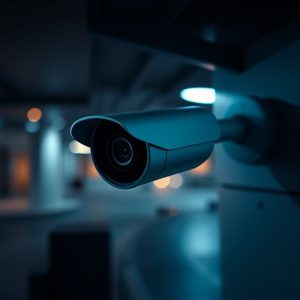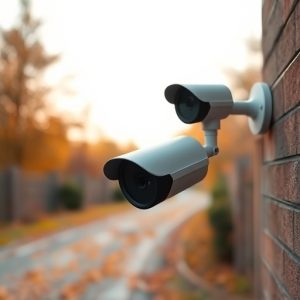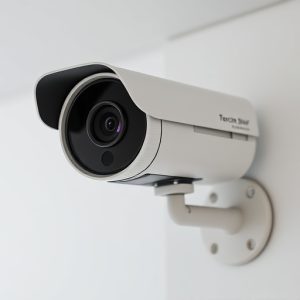Mastering Hidden Camera with Built-In DVR Systems: Installation, Features, and Security Best Practices
Hidden cameras with built-in DVRs have revolutionized surveillance technology, offering high-quality…….
Hidden cameras with built-in DVRs have revolutionized surveillance technology, offering high-quality, discreet monitoring solutions with enhanced features like motion detection, real-time alerts, remote access via mobile apps, and cloud storage. These devices are designed to blend into their surroundings while capturing clear footage, with added capabilities for night vision and audio recording for 24/7 functionality. They feature high-sensitivity imaging sensors for sharp low-light images and sound recording, which are crucial for legal evidence or casual observation. Users benefit from easy-to-use interfaces, expandable storage solutions, and various resolutions upwards of 720p to ensure clarity. Proper installation and configuration are essential for optimal performance, with considerations for the camera's field of view, storage capacity, battery life for wireless models, and enhanced security features like encryption and motion detection. For maximum security, it's vital to employ robust encryption methods such as AES 256-bit and adhere to best practices like secure network connections, regular firmware updates, strong passwords, and two-factor authentication. These measures help protect the data against unauthorized access and uphold legal standards for privacy. Users should select and manage their hidden camera with built-in DVR systems carefully to achieve the best security outcomes and peace of mind.
Title: Navigating the World of Hidden Camera with Built-In DVR Systems for Enhanced Security
In an age where security is paramount, hidden camera systems with built-in DVRs offer a discreet and effective solution for monitoring environments. This article delves into the intricacies of these sophisticated devices, from their capabilities to the installation process, ensuring you harness their full potential. We’ll explore key features that distinguish exceptional hidden camera DVR systems and provide guidance on setting them up for peak performance. Additionally, we’ll address the critical aspect of data security to protect your recordings. Whether for home surveillance or business protection, understanding these systems is essential for safeguarding what matters most.
Unveiling the Capabilities of Hidden Camera Systems with Built-In DVRs
In recent years, hidden cameras with built-in DVRs have become increasingly sophisticated, offering users a discreet yet powerful tool for surveillance and security. These innovative systems are designed to blend seamlessly into their surroundings, providing a clear field of vision while capturing critical moments without drawing attention. The integration of a DVR within the camera itself eliminates the need for additional equipment, simplifying installation and ensuring that footage is stored on-site, enhancing privacy and security. Users can benefit from high-resolution video playback, motion detection capabilities, and in some models, real-time alerts to their devices when activity is detected. This technology is ideal for a variety of applications, including home security, business surveillance, and personal safety. With advanced functionalities such as remote access through mobile apps and cloud storage options, these hidden camera systems with built-in DVRs deliver unparalleled peace of mind and situational awareness to users.
Moreover, the latest advancements in this field have led to the development of cameras that feature night vision and audio recording, expanding their utility beyond daytime observation. The images captured by these hidden cameras are clear and crisp, even in low-light conditions, thanks to high-sensitivity imaging sensors. Coupled with the ability to record sounds, these systems can serve as evidence for legal purposes or provide valuable insights into everyday activities. With user-friendly interfaces and expandable storage options, users can easily manage their surveillance footage, ensuring that important data is preserved without taking up excessive space. The evolution of hidden cameras with built-in DVRs has made them an indispensable tool for those looking to enhance their safety and security measures in a covert and efficient manner.
Key Features to Consider When Selecting a Hidden Camera with a Built-In DVR
When selecting a hidden camera with a built-in DVR, it’s crucial to consider several key features that will ensure the device meets your security needs effectively. High-definition video quality is paramount; look for cameras that offer at least 720p resolution for clear footage. The field of view, or viewing angle, also plays an important role in capturing the desired area without missing any critical details. A wider field of view can cover larger spaces, making it a valuable consideration for comprehensive monitoring.
Another vital aspect to consider is the storage capacity of the DVR. Determine the length of time you need to record and choose a camera system with sufficient memory, whether it’s via an SD card or internal storage. Additionally, check the battery life if the camera is wireless, as continuous operation without recharging or replacing batteries could be essential, depending on your use case. For remote access and convenience, a hidden camera with a built-in DVR that offers cloud storage solutions and mobile app connectivity can provide real-time alerts and video footage viewable from anywhere. Security features such as motion detection and encryption ensure that your recordings remain secure and that you’re alerted only when necessary, reducing the likelihood of missing critical events while minimizing storage space waste. Ensure the camera system you choose aligns with these technical specifications to guarantee a reliable surveillance setup that fulfills your safety requirements.
How to Install and Set Up Your Hidden Camera with Built-In DVR for Optimal Performance
To maximize the performance of your hidden camera with a built-in DVR, careful installation and setup are paramount. Begin by selecting an optimal location for your camera, ensuring it has a clear view of the intended area while remaining discreet. The placement should also consider the camera’s field of vision and any potential blind spots. Use the provided mounting hardware to securely attach the camera to a wall or ceiling, making sure it is level and stable to avoid shaky footage.
Once the camera is in position, connect it to the DVR system as per the manufacturer’s instructions. Establish a power source for both devices, ensuring that the cable is routed in a manner that does not attract attention. Utilize the built-in cables if available, and avoid unnecessary extensions to maintain image clarity and minimize the risk of interference or signal degradation. Set up the DVR by connecting it to a monitor or television if you wish to live-view the footage. Configure the DVR settings according to your needs, selecting the appropriate resolution, recording schedule, motion detection sensitivity, and storage preferences. Most systems come with an SD card slot or a hard drive interface for recording and storing footage. Ensure that the storage device is correctly inserted and formatted for use. After completing these steps, initiate a test recording to verify that both the camera and DVR are functioning optimally, checking for clarity of image, stability of the video feed, and proper operation of motion-triggered events. Regularly reviewing and adjusting settings can further enhance your system’s performance over time.
Maximizing Data Security: Best Practices for Storing Recordings from Hidden Camera DVR Systems
When deploying hidden camera systems with built-in DVRs, it is paramount to safeguard the footage against unauthorized access and data breaches. The security of these recordings is not just about protecting privacy; it’s also a legal requirement in many jurisdictions. To maximize data security for hidden camera with built-in DVR systems, consider implementing robust encryption methods for all stored footage. This encryption should be strong enough to deter hackers and prevent data tampering. It’s advisable to use hardware that complies with the latest encryption standards, such as AES 256-bit, which is widely recognized for its strength.
Additionally, ensure that your DVR system is connected to a secure network. Avoid using public Wi-Fi or unsecured networks for transmitting footage, as these can be easy targets for cyber attacks. Regularly update the firmware of your camera and DVR systems to address any security vulnerabilities. Employing strong, unique passwords for each device and changing them periodically is also a best practice. For added protection, consider enabling two-factor authentication if available. It’s equally important to limit access to the recordings to authorized personnel only, using role-based access controls where necessary. By adhering to these best practices, you can significantly reduce the risk of data breaches and ensure that your hidden camera with built-in DVR system operates securely.


